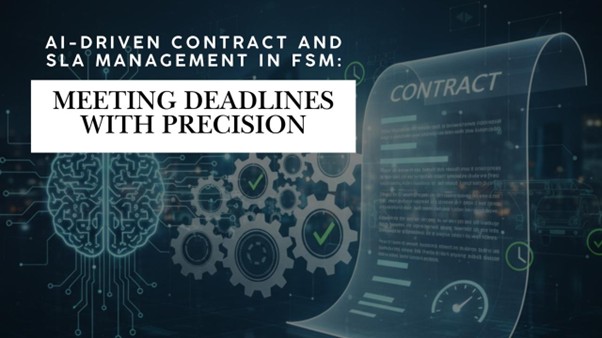AI-Driven Contract and SLA Management in FSM: Meeting Deadlines with Precision

Missing an SLA deadline doesn’t just cost money – it erodes trust. When a field technician arrives four hours late to repair critical manufacturing equipment, or when scheduled maintenance slips past its contractual window, clients start questioning whether your promises mean anything. For field service organizations juggling dozens of contracts with hundreds of moving parts, keeping every commitment feels like an impossible feat.
The math is brutal. Industry data shows that SLA breaches cost companies an average of 15-20% of contract value in penalties, not counting the long-term damage to customer relationships. A single missed response time on a high-value account can wipe out months of profit margin. Yet most field service teams still manage contracts using spreadsheets, email reminders, and whatever information their dispatchers can remember under pressure.
That approach worked when service operations were smaller and contracts were simpler. Today, it’s a recipe for failure. Modern field service contracts are complex beasts with tiered response requirements, escalation clauses, time-based penalties, and seasonal variations. Human brains aren’t wired to track this kind of multidimensional complexity at scale – but artificial intelligence thrives on it.
Why Traditional Contract Management Falls Apart
The fundamental problem with manual SLA management is that it treats contracts as static documents rather than dynamic operational requirements. Someone reads the contract, extracts key dates and metrics, enters them into a system, and hopes nothing gets missed. This works until reality intervenes.
Contracts change. Amendments get signed, coverage areas expand, equipment lists grow. Each change ripples through your operation, affecting scheduling priorities, technician assignments, and parts inventory. When these updates live in email threads and PDF attachments, critical details slip through the cracks.
Scheduling conflicts compound the problem. Your dispatcher sees that a technician needs to reach a site within four hours, but doesn’t immediately know that this particular contract has a two-hour window on Tuesdays, or that this specific equipment type requires a certified specialist. By the time someone catches the error, you’re already racing the clock.
Resource constraints make everything worse. You might have the right technician available, but they’re two hours away and stuck in traffic. Should you send them anyway and risk missing the deadline? Or dispatch someone closer who lacks the proper certification? These judgment calls happen dozens of times per day, and each one carries SLA implications that aren’t immediately visible.
How AI Transforms SLA Management
FSM contract automation powered by AI doesn’t just digitize your contracts – it actively interprets them, monitors compliance, and intervenes before problems escalate. The technology reads contract language, extracts obligations, maps dependencies, and translates legal terms into operational requirements that your systems can act on.
Natural language processing analyzes contract clauses to identify response times, resolution windows, coverage exclusions, and penalty triggers. This isn’t simple keyword matching – modern AI understands context, recognizes synonyms, and catches conditional requirements that human reviewers often miss. When a contract states “four-hour response time for Priority 1 issues during business hours, two-hour response for equipment failures affecting production,” the system maps this to specific scheduling rules.
Predictive analytics take this further by forecasting potential SLA breaches before they occur. The AI monitors technician locations, traffic patterns, job durations, and parts availability in real time. When it detects a scenario where meeting an upcoming commitment looks unlikely, it triggers alerts and suggests alternatives. Maybe there’s a closer technician who could be rerouted, or perhaps escalating the job priority would free up necessary resources.
Dynamic scheduling optimization represents the most powerful application of SLA management AI. The system doesn’t just flag problems – it actively rearranges schedules to prevent breaches. When a high-priority SLA obligation appears, AI automatically evaluates every possible technician assignment, calculates arrival times accounting for current conditions, considers skill requirements and certification levels, and recommends the optimal dispatch decision. This happens in seconds, not the 20 minutes a human dispatcher would need.
Real-World Impact on Service Operations
The operational improvements from FSM contract automation show up across multiple dimensions. Response time accuracy improves dramatically because the system knows exactly which commitments are time-critical and automatically prioritizes them. First-time fix rates increase because AI matches the right technician skills to contract requirements. Customer satisfaction scores climb as reliability improves.
Financial performance transforms even more dramatically. SLA penalty costs drop by 60-80% in most implementations simply because fewer breaches occur. Contract renewal rates improve because clients see consistent, reliable performance. Revenue per technician increases because better scheduling optimization means more billable work and less wasted time.
The human element matters too. Dispatchers and schedulers spend less time frantically checking contracts and more time handling exceptions that genuinely require human judgment. Technicians receive clearer job information including specific SLA requirements, so they understand when speed matters versus when quality takes precedence. Management gains visibility into compliance trends and potential risk areas before they become crises.
Implementation Considerations
Successful SLA management AI requires clean contract data as a foundation. Your existing contracts need to be digitized and structured so the AI can parse them effectively. This initial data preparation represents the biggest implementation hurdle, but it’s also an opportunity to standardize contract language and eliminate ambiguous terms that cause operational confusion.
Integration with existing FSM systems is critical. The AI needs real-time data feeds from your scheduling system, GPS tracking, inventory management, and customer relationship tools. Without these connections, it’s making decisions based on incomplete information.
Change management deserves serious attention. Your team needs to trust the AI’s recommendations enough to act on them, which requires transparency into how decisions are made. The best implementations pair AI suggestions with clear explanations so dispatchers understand the reasoning and can override when necessary.
For field service organizations serious about meeting SLA commitments while maintaining operational efficiency, AI-driven contract management has moved from competitive advantage to operational necessity. The technology handles the complexity that humans struggle with while freeing your team to focus on delivering exceptional service.
FieldEZ provides comprehensive field service management solutions that incorporate AI-driven contract and SLA management capabilities, helping service organizations meet their commitments with precision while optimizing resource utilization. Their platform integrates contract automation with real-time scheduling, technician management, and performance analytics to deliver measurable improvements in SLA compliance and operational efficiency.
References:
- Service Council Research Report on SLA Compliance Costs in Field Services (2024)
- Aberdeen Group – “The AI Imperative in Field Service Management” (2024)
- Gartner Research – “Artificial Intelligence Use Cases in Field Service Operations” (2024)
- Field Service Digital Transformation Study, Deloitte (2024)
- McKinsey & Company – “Unlocking Value Through AI in Service Operations” (2024)



